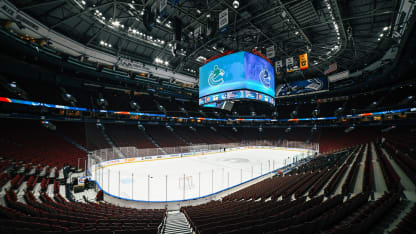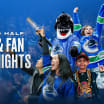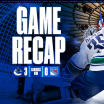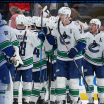Free agency is fast approaching, and the Vancouver Canucks are getting ready for the July 1st festivities.
After a season that saw the team reach game seven of the second round of the Stanley Cup Playoffs, the Canucks continue to focus on building a winning culture in the organization.
Preparing for free agency (and the trade deadline) is a year-round process for the Canucks. There’s a lot of anticipation around the first few days of July but planning and making strategic decisions lasts well into the summer.
Vancouver Canucks Director of Professional Scouting Brett Henning says the scouting department has a blueprint of the kind of player they’re looking for that will hopefully help the team reach the next level. It includes things that head coach Rick Tocchet has emphasized the significance of all season such as winning puck battles and board battles and being a consistent player.
“There are qualities that we want, and you want to provide players that fit into our system and who are also willing to go through a wall for their team. A lot of what goes into fitting into a winning culture is consistency and being there for your teammates. The team that you want to build is going to go through adversity and hopefully come out the other end,” Henning said.
No two players are the same, nor do they want everyone to be the same, but there are certain characteristics they’re looking for. It’s up to the scouts to find players with the right attitude and skills that embody those characteristics.
Hockey operations, the coaching staff and scouts narrow down a five-page list of NHL and AHL players they’re interested in that will be free agents by the end of the season. There are check-in points like midterm meetings, but the list is fluid, and it gets finalized at end of year meetings. There’s no set number of players they’re looking for per position so some positions might only have one player targeted while there might be 10 players on the list identified for a depth spot.
“If you have everyone on the list, you have no one on the list,” Henning said. “Overall, the list might have 50 to 75 players on it and that's over the course of the year. The first part of the year you're crossing off names and then you're kind of moving the list around.”
Armed with the list and what the franchise is looking for in a player, the scouts watch games and take copious amounts of notes on how each player’s season unfolds. A West region scout, Henning went to 150 games last season, including games from the Eastern conference.
“The scouts do a great job in their territories, and they have guys who are targeted, either free agents or young players that could be part of a trade. There’s so much trust between everyone in the group and having trust in the scouting group is important,” Henning said.
Over his 14 years as a pro scout, analytics has gradually made its way into player assessment and Henning says finding the perfect balance between the eye test and analytics can be tough. Pro scouts use the eye test when they’re at the rinks watching and writing reports and employ analytics to either complement what they’re seeing or highlight areas to focus on.
“The analytics highlight smaller details that you can focus on when you go to a game, and our team does such a great job, it's a different perspective and it's very helpful for us. When we're at the rink we’re looking to see how players progress; if they fall off over the course of the season or if these young players keep getting better,” Henning said.
As a pro scout, the framework is the same every year, but every year you’re looking for different personnel so being prepared and nimble is important.
“I learn something new every day, it's so humbling,” said Henning. “You learn to keep your mind open – for example, watching a young player and for a year and a half he hasn't done anything and then all of a sudden, they raise their level of play and you're thinking ‘Oh my gosh, I didn't see that coming.’”
After the initial wave of free agency, things become quieter but it's still a crucial time for teams to build their rosters as they continue to look for players to enhance their depth. There are no NHL games to attend, but the World Junior Summer Showcase is an example of a good opportunity to see professional talent, as many of the players have already been drafted.
Henning says there are different considerations when scouting during the summer months than during the traditional hockey season.
“It’s hard scouting in the summer because players have varying levels of access to training facilities; for example, a player from Northern Sweden might not have been on the ice for a month due to a lack of rinks, while a player from Minnesota might be training five days a week and have an advantage,” he said.
As July 1st approaches, the Canucks’ scouting team is keeping a close eye on the playoffs looking for players that will fit their blueprint for success.
The hard work behind the scenes on the year-long march towards free agency has been done and the team is focused on strengthening their roster for the upcoming season.
Insider Extra
Just having come through the playoffs, what's your process like through the playoffs?
“The playoffs are a different animal and obviously we haven't been at this stage of the game in a while. I was doing pre scouting, so we'd have scouts on different series specifically with who we could possibly play next. So even leading up a little bit into the playoffs, the last little 10% stretch of the season we shift a little bit. Our whole job during the year is focusing on individual players, obviously you have to know the team as well, but you’re highlighting the free agents at the games, the young players, a guy that you think is getting better or getting worse and you want to really focus on those guys.
In the playoffs you’re more so watching the team in its entirety. The coaches have so much video and they're so good, but if you can pick out one little thing that can help whether it's a weakness that you see, a faceoff play, something like that you're more team focused in the playoffs. Every team that is in the playoffs obviously has free agents and different players so maybe I’ll write on one or two free agents just because you're seeing them play at the highest level.
I'm here in Denver, I sat in Colorado, Winnipeg series, I went to Winnipeg and saw every game and it’s so fun, obviously because of the environment, it’s a great time of the year and that's what you're playing for. It's a different mentality as a as a pro scout when it comes to the playoffs as far as what we did this year.”
Are your busy seasons trade deadline and free agency? Which one is usually more hectic?
“Those are the pinnacle dates. They're both hectic in their own ways. For the trade deadline there's a lot of lead up. It’s shaped more in free agency but at the trade deadline, everything can happen so quickly. If a deal falls apart for another team, they're suddenly coming back to you as plan B. You're trying to make a trade and they want more than you're willing to give, so you go to plan B, so there's a lot of moving parts and then obviously you have that deadline, and everything stops. So, you're watching all these trades come in, and some are surprising, some that you thought would happen and that takes people off the board. It's a lot of moving parts that happens in a tight period at trade deadline.
And then in free agency, you are more targeted, you're building those lists, looking at these players over the course of a year because you know that their contracts are up. You obviously can't talk to them because they're still under deals, but you see it coming, you see where you need players to fit on your team.
In my opinion, I think the trade deadline is just a lot of moving parts and then in trying to sort that out is probably a little more chaotic.”



















